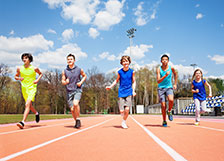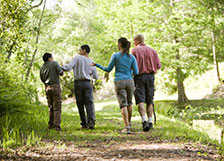In this section
Community partners and professionals
- Child abuse prevention
- Child Advocacy and Protection Services (CAPS)
- Child Welfare Services
- Memberships and accreditation
- Child well-being: Strong Families, Thriving Children
- Resources for schools
- Nutrition ages 2 to 4
- Nutrition ages 5 to 12
- Nutrition 13 and up
- Physical activity ages 2 to 4
- Physical activity ages 5 to 12
- Physical activity 13 and up
- Healthy minds ages 2 to 4
- Healthy minds ages 5 to 12
- Healthy minds 13 and up
Physical activity-ages 13 and up
These short activities and engaging mini-lessons are a great way for families to learn about the importance of getting physical activity each and every day.
Benefits of physical activity

Physical activity helps keep bones, joints and muscles healthy, but it's important for other reasons too.
Studies have shown that physical activity can have a positive impact on mental health and can help to improve the quality of sleep that teens get. Mood can be improved and energy levels increased through physical activity.
Other health benefits include reduced risk for type 2 diabetes, reduced risk of heart disease and reduced risk of obesity. It helps kids and teens develop healthy habits for life!
Encouraging a variety of exercise
Doing the same thing over and over again can get boring for teens, so it's important that they switch things up to keep them interested in different activities.
Taking classes at a local recreation department or community center can be a great way to introduce them to new activities.
Motivating teens to be active
One of the best ways to motivate your teen to be active is to find activities that are fun and that they enjoy doing. Start slow, give them control on how to be physically active and make sure that it fits within their schedule.
Instead of emphasizing weight or physical appearance, emphasize that your teen will feel better. It can be helpful to talk about your own experience with physical activity and one of the best things you can do is lead by example! Invite your teen to join you at the gym or on your walks in the evening.
The importance of stretching and warming up
Stretching can help to reduce injuries, improve athletic performance and promote a healthy lifestyle. It does this by reducing tears or pulls in muscles and it helps with joint health because of increases in flexibility, range of motion and blood flow to muscles. Stretching can also help to improve mood, breathing and posture for teenagers along with speeding up recovery. Stretches should be maintained for 10-30 seconds at a time.
Watch the home warm-up video below to learn how to properly warm-up before physical activity.
Helping teens stay active
Ideas for working out at home
Watch this home strength video for some at home activity ideas:
Here are some additional ideas for teens for working out at home:
- Do some activities during commercial breaks. Things like jumping jacks, push-ups, crunches, jogging in place, squats, jump squats, chair dips or lunges work well. If your show doesn't have commercials, set a timer for regular activity breaks.
- Walking or running up and down the stairs or doing a wall sit while you brush your teeth for 2 minutes can also help you get active at home. Try doing some arm curls with canned foods or milk or try jumping rope. While you're doing things like washing dishes, try standing on your toes to do some calf raises to get in some extra movement.
- Watching exercise on demand videos or working out using YouTube videos are great options for working out at home as well. There are a lot of options, so you should be able to find something that fits for you.
- Complete a family challenge to get in one hour of physical activity each day for one week. To keep it fresh, mix-up the types of activities done each day. Some examples could include, walking the neighborhood, hiking the local or state park, play a game of whiffle ball or football in your yard, go to the local pool for a swim, find an open gym and play basketball or volleyball, or go for a bike ride. If walking in your neighborhood isn't possible, check-out the local high school/community track.
Talk to your kids and teens about any changes they may have noticed since getting more active, including any changes in sleep and mood.
How much activity do teens need?
It's recommended that kids and teens get 60 minutes of physical activity each day, but a lot of teens fall short of meeting this recommendation. Most of that activity should be moderate or intense aerobic activity, and in addition, muscle and bone strengthening activities should be done at least 3 times a week.
Alternatives to sports
 Organized sports or teams aren't the only way for teens to be physically active. Things such as hiking, going for a bike ride or doing chores that involve movement can help them stay healthy.
Organized sports or teams aren't the only way for teens to be physically active. Things such as hiking, going for a bike ride or doing chores that involve movement can help them stay healthy.
Enter into a community 5K run or walk with your teen and train for the event together. Let your teen choose the cause you will run or walk for and think about letting them invite a friend to join.
Tips for athletes
How to help prevent sports injuries
Talk to your athlete so that they know they can come to you if they have pain or if something doesn't feel right. Sometimes, they'll try and push through pain which can make things worse. Be sure to get your athlete a physical before the sport season starts to make sure there aren't any concerns from their doctor.
Cross-training can help reduce overuse injuries by using different muscles and joints. Participating in multiple sports during the year is another good way to stay in shape while focusing on different muscle groups and joints.
Warming up is also an important habit for all student athletes. Warming up should consist of dynamic, or moving, stretching and static, or still, stretches.
Rest is also important for athletes, as being tired or experiencing fatigue can lead to sports injuries.
Hydration can help reduce heat related illness in athletes, and it's also important for overall health. Along with hydration, nutrition plays an important role in keeping your athlete healthy. A well balanced diet filled with fruits, vegetables and lean protein will fuel them for practices and games.
Proper equipment that fits well can help to prevent injuries. Things like helmets, pads and properly fitting shoes can keep teens safe. Alongside equipment, proper technique can help to prevent injuries. Be sure to talk to their coach and make sure they're following guidelines for things like proper tackling, proper throwing technique and the number of repetitions each day.
The impact of nutrition for teens in sports
Teens who are in sports will likely need more energy, or food, along with additional hydration. Besides the extra energy, teen athletes have some specific nutrient requirements that will keep them performing at their best.
- Calcium helps with bone strength and is important to avoid breaks or stress fractures. Low-fat dairy products and leafy greens are good sources of calcium.
- Iron helps with oxygenation of the body and can be found in lean meats, dried fruits, leafy green vegetables and fortified whole grains.
- Protein helps with building and repairing muscles, and most teens get enough protein through a balanced diet. Lean meats, fish, dairy products, beans, nuts and soy products are good sources of protein, but remind your teen that consuming too much protein can lead to calcium loss and dehydration.
- Carbohydrates provide the energy needed to participate in sports and they're an important source of fuel for athletes. Whole grain choices such as whole wheat pasta and breads, fruits and vegetables are good choices for carbohydrates.
When it comes to hydration, water is the best option and it's recommended that athletes drink fluids every 15 to 20 minutes while doing physical activity. It's also important to properly rehydrate after activity. Sports drinks are a good option, as they contain electrolytes, for athletes who engage in strenuous activity for more than one hour.
On game days, a healthy meal should be eaten 3 or more hours before the start of the game and it should consist of carbohydrates, a moderate amount of protein, and it should be low in fat. After the game, it's a good idea to eat carbohydrates within 30 minutes and again two hours later.
